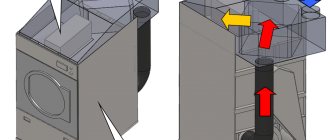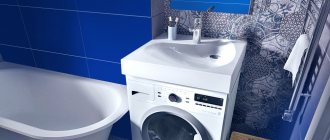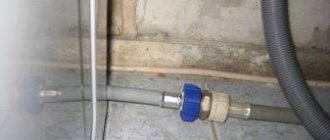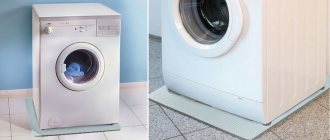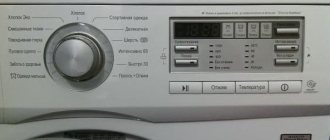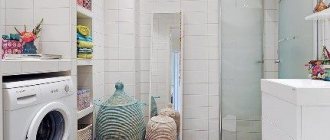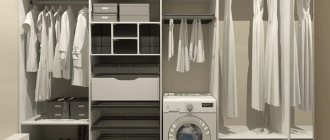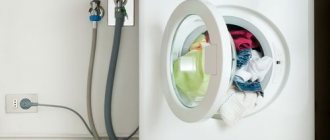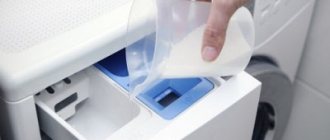The popularity of tumble dryers is growing. It is not difficult to install the equipment yourself.
It can be problematic to find a place in the room where the volumetric apparatus will be located. In this case, installing a washing machine and dryer in a column will be the ideal solution.
- Column installation technology
- Types of dryers
- Correct connection
- Vertical installation
- In the horizontal plane
- Expert recommendations
- Catalog of washing machines with reviews
Column installation technology
How can you place two devices to save more space? Recently they have been arranged in a column. In this position, the machines are as close to each other as possible and occupy a minimum of space, which saves not only space, but also the user’s personal time.
Dryer above washing machine
Washer under dryer
With this type of arrangement, the washing machine is located below the dryer. This can be done in any convenient room. The location of such a set of devices can be a bathroom, kitchen, corridor and even a storage room.
In this case, it is necessary to ensure that the vibration created during operation of one device does not affect the second. Otherwise, it may negatively affect its performance.
Installation options:
- You can use the mounting bracket that comes with dryers.
- Using slats fixed above the washing machine. In this case, it is necessary to take into account the load on the shelf and wall.
- Installation in a niche.
The installation option is selected individually according to the wishes of the owner of the equipment, as well as the complex characteristics of the room in which it is planned to install the washing machine and dryer in a column.
Types of dryers
The market offers models from brands that are popular: Bosch, Siemens, Miele, Asco and others, with a different set of characteristics. Their installation method varies depending on the type.
- Condensation. The heated air is circulated by the drum. During operation, condensate is collected in a special tank. Therefore, there is a need to empty the collection container after each use of the device.
- Exhaust. Air is drawn in and discharged through the hood.
- With heat pump. Operation is provided by an evaporator. Excess moisture is discharged into the sewer drain.
Are you unplugging your washing machine?
Oh yes! No
The most popular models are ventilation type; they can be installed in apartments and private houses. Other options are not as popular.
There are several ways to install together:
- dryer above washing machine;
- both devices side by side in a horizontal position;
- in a plasterboard niche;
- under the countertop or sink.
Installation option
Mounting options
Manufacturers of household appliances for the home have several types of clothes dryers in their line: exhaust, condenser and heat pump. Connecting a dryer of each type has its own characteristics, which is caused by the operating principle of the machines. For example, exhaust models perform drying by removing air with moisture into the ventilation system. Condensation products work as follows: heated air enters the chamber with laundry, collects moisture and passes through an installed heat exchanger. After this, the moisture settles in a special tray, which must be emptied after each turn on. As for machines with a heat pump, they essentially work in a similar way to the previous option. The only difference is that the moist air does not pass through the heat exchanger, but through the evaporator.
In private houses and apartments, exhaust dryers are most often installed, which need to be connected to ventilation and electricity. If it is not possible to remove the air duct, it is recommended to connect a condensation model, in which water is discharged either into a tray or into a sewer. Let's consider two existing installation options: for ventilation and for sewerage, but first let's talk about how you can install a dryer in a room.
Mounting bracket
To place the dryer on top of the washing machine, you can use special mounting brackets, which are often supplied with the device. If they were not included in the kit, you will have to purchase such parts separately.
The fasteners are installed on top of the washer body so that the dryer can be attached to them. Without mounting fasteners, you should not install the device on top of the washing machine, since without reliable fixation the product may tip over due to operating vibration. Also, such fasteners are installed to additionally protect the surface of the dryer from scratches and other damage.
Reiki
Some people do not want to use mounting fasteners and therefore try to secure products in other ways. Often, strong wooden slats are used for this, which are attached to the surface of the wall. Then a dryer is attached to the installed slats, installed on top of the washing machine.
It is necessary to attach the slats to the wall very carefully and securely so that the structure does not become detached and fall.
Niche
There are times when it is not possible to place a dryer on top of a washing machine and you have to look for other methods of fastening. The most common is the use of a special niche, which is installed on the floor surface. You can purchase it or make it yourself. To make a high-quality niche, you can use high-strength plasterboard. When installing the device in a niche, you must remember that vibration occurs during its operation. Therefore, the distance between the wall and the structure should be 3-4 centimeters.
Vertical installation
By installing a dryer above a washing machine, you can save as much useful space in your home as possible. This simplifies access to devices during use. The devices can be installed in any room. Before starting work, you need to take care of the availability of communication connections. More details:
- The SMA must be placed in the right place. This should be done on a flat surface, moving at least 3 cm away from the wall.
- Install the mounting bracket with the dryer stand. At the same time, make sure that there is a rubber seal underneath it. It will reduce vibration levels.
- Secure the stand with bolts.
- Place the dryer so that its feet fit into the grooves on the stand.
- Secure the recesses from the outside using plugs.
Expert opinion
I work in the household appliance repair industry. Extensive experience in restoring washing machines and dishwashers.
Ask a Question
Attention! The vertical column option is the most difficult to implement. When performing work, safety and installation rules must be strictly observed. The structure must be securely fastened. Installing a column without special fastening is strictly prohibited.
Important points:
- Before using fasteners, you should make sure they are secure.
- It is necessary to take into account how much the wall will withstand the load.
- You will have to use the devices one at a time.
- Both the washer and dryer should be about 3cm away from the wall.
The MCA should be at the bottom, but not vice versa. Its weight is much greater and vibrations during operation are stronger. Therefore, the dryer, regardless of the model and brand, is always placed at the top with this installation method.
Placement in a column
In the horizontal plane
Perhaps this method is much simpler and does not require any special fasteners. Having a washing machine and dryer next to each other is very convenient. This installation option is suitable if there is sufficient free space.
Expert opinion
I work in the household appliance repair industry. Extensive experience in restoring washing machines and dishwashers.
Ask a Question
Installing the equipment couldn't be easier. Two devices are placed side by side, grounded and connected. Alternatively, they are placed in a special niche. You can make it yourself from wood or drywall. In this version, the technique looks more aesthetically pleasing, but the process requires money and time.
Under the sink or countertop
The most “compact” way to create a vertical column involves installing it under a countertop or sink. Moreover, they can be in close proximity to each other. For this installation option, it is necessary to provide for the availability of communications in advance, as well as the possibility of embedding at the washing machine.
budem_menyat
mielekharkov
alexandra_zadorozhnaya_design
premiumtech_tver
primaveratomsk
bosch.siemens.neff
How to connect
There are certain features of connecting a dryer that need to be dealt with in advance.
Ventilation
Siemens and Miele exhaust models must be connected to ventilation ducts. At first glance, this does not present any difficulty. The air duct from the kit is connected using a flexible corrugated hose to the ventilation hole and secured with standard clamps. However, for proper installation, important nuances should be observed:
- Preference should be given to the option in which the hose has a minimum number of bends. In this form, air and condensate exit without obstruction.
- It is not recommended to create creases on a corrugated hose with sharp and right angles. In this embodiment, their conductivity decreases. Curves should be gentle and not create obstacles.
- In rooms with high air temperatures, where condensation forms in increased quantities, it is preferable to use a straight hose. Thus, its quantity will be less.
- If there is no central ventilation shaft, you must create an air duct yourself. In an apartment, he can go out the window. In private homes there are other options available.
Sewerage
When installing Bosh, Asko, Miele, Siemens (or other brands) condensing dryers together with washing machines, connecting both devices requires a sewer drain. In this case, there will be no need to periodically drain the condensate that accumulates in the standard dryer tray. There are several options for resolving this issue:
- Connect the drain to the sewer pipe. Not the easiest way, since you will need special equipment to create the necessary hole. When connecting independently, this is not always possible.
- As an alternative, a siphon is used. In this case, it must be purchased specially. This should be a combined siphon with several pipes.
- The easiest way is to temporarily secure the drain pipes in the sink area, but it is far from the most reliable.
Expert recommendations
More details:
- You should not install devices one on top of another just like that. This is a gross violation of operating rules and regulations and is therefore strictly prohibited.
- While the dryer is running, the washing machine should be turned off and vice versa.
- Do not forget that vibrating devices should not be placed close to the wall. There should be at least 3 cm between them.
- Two devices of the same brand are more convenient to use, and this option should be preferred.
- If it is impossible to purchase devices from the same company, they must still fit in size.
Installing washing machines and dryers in a column is a rational and simple way. If you have certain skills and desire, you can do this yourself.
But before you start work, you need to study all the nuances. You should take care of the accessibility of communications, prepare a mount if necessary, and also carefully read the operating instructions for the device.
Video
Myth 9. Drying spoils items made from delicate fabrics.
In the new Candy models, drying is implemented using a heat pump, that is, a lower temperature is used than in condensing machines. This in turn does not wear things out, as already stated. Also, let's not forget about special drying modes, for example, the mode for wool - they are designed specifically for delicate fabrics.
In addition, modern washer-dryers are equipped with a steam mode, which not only saves electricity, but also helps to carefully wash delicate fabrics: steam treatment resembles boiling in its effect, but colored fibers retain their color. By the way, steam also disinfects clothes quite well, which is very important for children's clothes or things for people with allergies.
